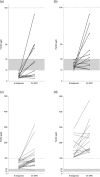Significance of low ferritin without anaemia in screen-detected, adult coeliac disease patients
- PMID: 35925673
- PMCID: PMC9805163
- DOI: 10.1111/joim.13548
Significance of low ferritin without anaemia in screen-detected, adult coeliac disease patients
Abstract
Background: Low ferritin without anaemia has been linked to adverse health effects.
Objectives: To investigate the prevalence and clinical significance of low ferritin in screen-detected coeliac disease.
Methods: Seventy-six screen-detected coeliac disease patients were enrolled in the prospective collection of comprehensive clinical, laboratory and histological data at diagnosis and after 1-2 years on a gluten-free diet (GFD). All variables were compared between patients with different ferritin levels.
Results: At coeliac disease diagnosis, six patients had anaemia. Of the 70 nonanaemic patients, ferritin levels were <15 μg/L in 21%, 15-29 μg/L in 19%, 30-99 μg/L in 36% and ≥100 μg/L in 24%. Those with lower ferritin were more often females, had lower body mass index, haemoglobin and villous height-crypt depth ratio and also had higher intra-epithelial lymphocyte CD3+ levels in duodenal biopsies. The groups did not differ in neurological or gastrointestinal symptoms, health-related quality of life, bone mineral density, liver values, vitamin, albumin or coeliac autoantibody levels or the prevalence of comorbidities. Median ferritin levels increased from 41.5 μg/L to 86.0 μg/L on GFD (p < 0.001). Ferritin remained <30 μg/L in 21% of patients but was not associated with dietary compliance, nor was any correlation between changes in ferritin and quality of life, gastrointestinal symptoms, autoantibody levels or degree of histological damage detected.
Conclusion: Decreased ferritin is a frequent finding in screen-detected coeliac disease and may not be fully restored on a GFD. However, low ferritin levels are not associated with more severe symptoms or poorer quality of life.
Keywords: coeliac disease; ferritin; follow-up; quality of life; symptoms.
© 2022 The Authors. Journal of Internal Medicine published by John Wiley & Sons Ltd on behalf of Association for Publication of The Journal of Internal Medicine.
Conflict of interest statement
Marleena Repo, Laura Kivelä, Katri Kaukinen and Kalle Kurppa have received personal lecture fees from the Finnish Coeliac Society outside the submitted work, and Laura Kivelä, Katri Kaukinen and Kalle Kurppa serve as members of the advisory committee of the Finnish Coeliac Society.
Figures


References
Publication types
MeSH terms
Substances
LinkOut - more resources
Full Text Sources
Medical

